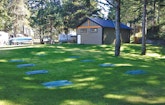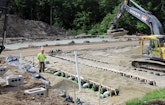Interested in Systems/ATUs?
Get Systems/ATUs articles, news and videos right in your inbox! Sign up now.
Systems/ATUs + Get AlertsTreatment system helps retail center comply with water-quality regulations
Problem: The Locust Grove, Va., Town Center houses more than 20 businesses, including a gas station, dry cleaner, laundromat, multiple restaurants and a market. The commercial site had a high-strength waste output, and the water directly discharged above grade into a tributary of Flat Run Pond, connected to the main lake as part of the Lake of the Woods residential subdivision two miles to the northeast. The Virginia Department of Environmental Quality required the facility to upgrade its 4,500 gpd wastewater treatment tank to comply with water quality regulations.
Solution: The retail center owner selected the Magellan Wastewater Treatment System from Contech Engineered Solutions that uses steel-reinforced polyethylene (SRPE) technology. Contech partnered with AppTech Solutions, a Virginia-based engineering firm specializing in SRPE products for sustainable water-quality systems.
Result: After submitting plans to the state DEQ, Contech constructed the 8-foot-diameter, 37-foot-long system in six weeks and shipped it in one truckload to the job site. Local contractor Titan Construction installed the system. The day prior, they excavated the site. The entire installation was in the ground and backfilled in four hours. 800/338-1122; www.conteches.com.
Passive advanced treatment used for family’s dream lake home
Problem: The owner of a lake lot in Lakemont in Rabun County, Ga., dreamed of building a home on the parcel deemed unbuildable since the 1940s. Two major challenges with the site were having Lake Rabun border one side of the property, and the lot being divided by a public road. The lot is 0.36 of an acre, with a 30- to 65-percent slope.
Solution: Harold Kilgore of Gravelator Systems and Ward Cleveland of A & W Soils combined their knowledge to offer a solution for the property owner. The decision was the installation of a low-maintenance, Georgia Class 1-approved, Eljen GSF system to provide the needed performance for the extreme topography and the property’s soil conditions. A duplex grinding station allowed wastewater to be pumped across the road to a 1,500-gallon traffic-rated combination septic/pump tank that needed to be placed in the home’s parking area. From that point, the effluent was lifted higher up on the lot, where a 3-foot-wide Eljen GSF Sand Trench System was installed.
Result: After planning and site preparation was completed, a septic permit was issued and construction began. The system was installed in November 2013, allowing the owners to move into their dream home. 800/444-1359; www.eljen.com.
Biofilter system provides treatment solution for RV park
Problem: Cape Lazo RV and Campground is an ocean-side property located a short distance from Comox, B.C., Canada, on Vancouver Island. The park, originally developed in the early 1970s, went through a complete upgrade with modern landscaping and new onsite facilities. This project also required replacement of the original septic system, which would not accommodate the renovated property. The solution needed to offer a small footprint with a strong emphasis on sustainability and environmental protection, and be practically maintenance-free.
Solution: In collaboration with Yellow Truck Septic in Comox, Premier Tech Aqua provided a cluster of nine fiberglass ST-750 Ecoflo Biofilters with 100-percent-organic filtering media. The modular design offered the required low footprint, as well as all maintenance, discharge and budgetary requirements. The system provides a permanent and durable solution that treats wastewater without requiring relocation or excavation. At the end of its useful life (up to 15 years), the used filtering media is removed and replaced via the cover and its 10-year warranty is automatically renewed.
Result: Supported by an annual maintenance program, the treatment station steadily produces a quality effluent of less than or equal to 10 mg/L in CBOD and less than or equal to 10 mg/Lin TSS. 800/632-6356; www.premiertechaqua.com.
Community installs cluster system for passive treatment
Problem: The Blodgett Landing Treatment Plant in the southwestern part of New Hampshire would routinely have parts of its treatment system freeze, hindering operation. The cold weather was also affecting treatment levels and inhibiting the nitrification and denitrification process. The facility had a 34,000-gallon Imhoff tank that was nearly 50 years old and needed to be replaced. The system was also not large enough to deal with the increased capacity.
Solution: The community chose the Enviro-Septic System from Presby Environmental. The passive wastewater treatment system is tested and proven to remove up to 99 percent of wastewater contaminants such as BOD, TSS, TN, TKN and fecal coliform. It uses fabrics and fibers to naturally establish multiple bacterial treatment environments throughout the system that break down and digest wastewater contaminants without the use of electricity or additives. Systems have proven effective in cold weather, which made it ideal for this location. The warm effluent combined with the biological process within the pipe generates enough heat to prevent system freezing.
Result: The Blodgett Landing Treatment Plant is designed as a recirculating system with the multilevel configuration, handling flows ranging from 2,500 to 88,000 gpd. “Since it was installed in 2011, the system has consistently exceeded the required effluent treatment levels,” says Tim Mulder, Blodgett Landing Treatment Plant manager. “The upfront cost-saving of this technology, along with its ability to perform with minimal ongoing cost and maintenance makes it truly exceptional.” 800/473-5298; www.presbyenvironmental.com.
System provides nitrate control
Problem: When owners of a condominium complex in Harbor Springs, Mich., discovered 20 years of septic effluent had increased their groundwater nitrate concentrations, the state required them to upgrade their system.
Solution: The condo’s aerobic bacterial generator seemed to change the microbiology in both the treated septic tanks and in the surrounding soils. Facultative bacteria prevented nitrate from forming in the tank, but when the ammonia reached the soils, it was converted to nitrite – then to nitrogen gas directly – even with oxygen present. They installed a test system with SludgeHammers and a Geoflow drip system, then monitored leachate with lysimeters to confirm that it only took 18 inches of soil to reduce total inorganic nitrogen to less than 5 mg/L.
Result: After seven years of operation and a comprehensive review of data from both old and new groundwater monitoring wells, tests showed a steady reduction of nitrate over the period of system operation. The condominium owners have been able to retain existing septic tanks with the SludgeHammer upgrade for nitrogen reduction. They have also been able to remediate long-term contamination of groundwater with the combined SludgeHammer and Geoflow drip system at a financial savings. 800/426-3349; www.sludgehammer.net.










